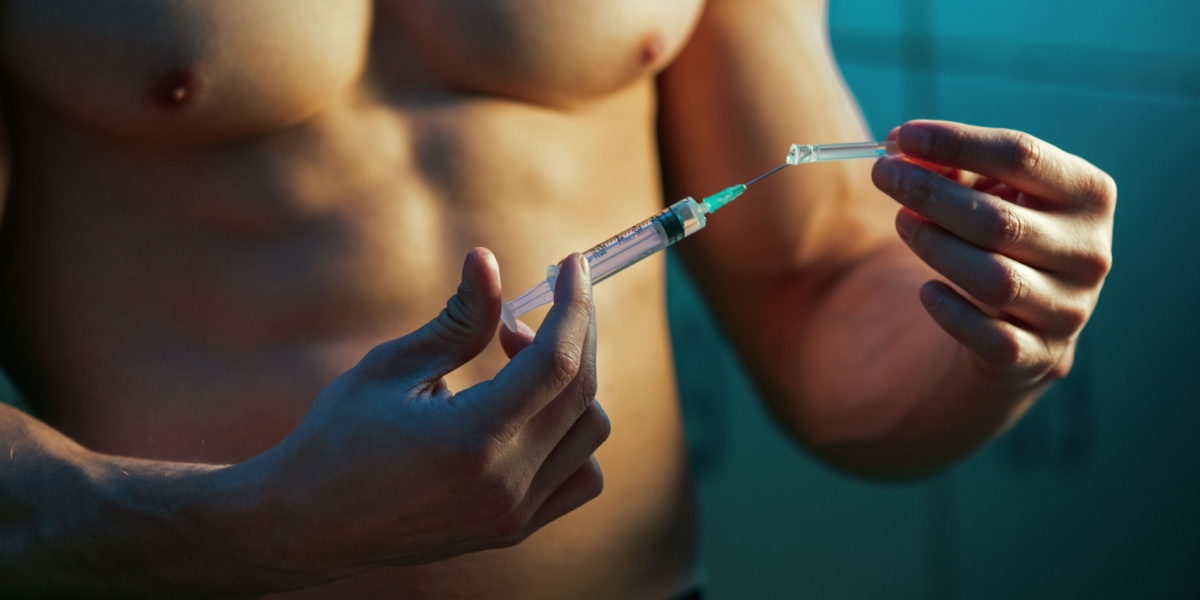Anabolic steroids, also known as 'roids' or 'juice,' are commonly-used drugs with serious potential side effects. Current estimates suggest that approximately 6% of men have used anabolic steroids at some point in their lives.[1] This includes 2.9-4 million Americans.[2] Steroid use in women is far lower, with around 50 male users for every female user.[1][3]
Anabolic steroids are commonly used for their muscle-enhancing effects and impact on sporting performance.[1]
Here’s everything you need to know about anabolic steroids and their effects.
- Anabolic steroids are synthetic variations of testosterone that enhance muscle growth but can cause serious health risks, including cardiovascular issues and hormone imbalances.
- Steroid abuse can lead to severe long-term effects, such as infertility, liver damage, heart disease, and psychological changes like aggression and mood swings.
- Steroid addiction is possible, with withdrawal symptoms including depression and fatigue. Treatment options include medical therapy and behavioral support.

What are anabolic steroids?
Steroids are a type of molecule defined by their structure. Some, such as testosterone or cortisol, occur naturally in the body, while others are man-made. When people talk about “taking steroids”, they usually mean synthetic variations of testosterone.[4]
Steroids vs. Anabolic steroids
There are two main types of steroids: corticosteroids and anabolic steroids. Corticosteroids are used medically to reduce inflammation and treat conditions like arthritis and asthma.[5]
Anabolic steroids work differently. They use the energy your body generates to increase cell growth. Anabolic-androgenic steroids (AAS), which are similar to the male sex hormone testosterone, lead to increased muscle growth.[6]
How are anabolic steroids administered?
AASs are usually taken orally in tablet form or injected.[6] Some steroid users will take them for extended periods, but many will alternate periods of use with periods of abstinence. This process is known as cycling.[4]
Injecting anabolic steroids provides more bioavailability than oral steroids, which are broken down by the liver prior to absorption. Improvements in oral formulations have made them more therapeutic, but there remains a substantial risk of liver toxicity with oral AAS.[7]
Effects of steroids
AASs may be prescribed for the treatment of select medical conditions.[8] They can also be used off-label to reduce muscle wastage in diseases like AIDS.[4] When AASs are used for body enhancement, they are typically taken in doses between 10 and 100 times higher than prescription doses.[4]
Below are the main effects of AASs at these elevated dosages. Because the overwhelming majority of steroid users are men, less research has been carried out on their impact on women, and this is reflected in the effects described.
Short-term effects
The main effect many people are aiming for in their steroid use is increased muscle growth.[1] This muscle growth is especially pronounced when steroid use is combined with resistance exercise, such as weightlifting, and it typically comes without an increase in fat.[4]
In the short term, steroid use is often associated with reduced fatigue, decreased need for sleep, positive mood and energy, and a willingness to train through pain.[9][10] Other users can report more negative effects on mood and mental functioning, however, including irritability, mood swings, and forgetfulness.[9]
The short-term effects of steroid use are thought to be relatively similar in women, including muscle growth and a reduction in body fat percentage.[3]
Long-term effects
The effects of long-term AAS use are considerably more negative, which is one reason why many steroid users will alternate between periods of use and abstinence, recognizing the need to reduce the strain on their bodies.[4]
Men can experience decreased sperm production, enlarged breasts, and male-pattern baldness.[11] Women may experience an irreversible deepening of their voice, increased growth of body hair, and a decrease in breast size.[6]
Emotionally and psychologically, long-term steroid use is associated with impulsiveness, suspiciousness, poor judgment, and mood swings, as well as aggressive and violent behavior.[10]
Long-term steroid use is also strongly associated with other substance abuse, including cocaine, injectable drugs, and marijuana.[4][12]
Steroid abuse
Steroid use to improve strength, athletic performance, or appearance is considered steroid abuse.[4] There are no medical or therapeutic benefits to the high doses required to achieve these effects, and the risks of negative consequences are significant.
Why do people abuse steroids?
People abuse steroids to increase their muscle gain, cheat in athletic or sporting competitions, or change their body’s appearance.[4] Many do not recognize or believe the risks inherent in steroid abuse or consider whether the increased confidence they experience is worth the risk.[7]
Adverse effects of steroid abuse
As mentioned, many of the longer-term effects of steroid use are harmful. Anabolic steroids are harmful to the cardiovascular system, leading to high blood pressure and increased risk of blood clots, stroke, and a 2.9 times increased risk of non-ischemic heart disease.[1][11]
Adverse effects are very common in steroid users, with some affecting over 10% of users. Examples in male users include acne, breast growth (gynaecomastia), and erectile dysfunction.[1] Male users of steroids are also 2.4 times more likely than non-users to be infertile.
Because steroids are frequently injected, many steroid users also risk adverse consequences from sharing needles, such as hepatitis or HIV.[12]
Testosterone itself is not harmful to the liver, but many synthetic steroids are and can lead to liver damage and tumors.[3][11]
There is also some concern that steroid use can cause structural changes to the brain, including decreasing brain volume and reducing the thickness of the cortex, although further research will be needed to confirm this.[13]
Can steroid use be addictive?
Steroid use can be addictive and approximately 30% of all steroid users are considered to be dependent.[4] Steroid addiction is associated with withdrawal symptoms and continuing use despite negative consequences, such as increased aggression or decreased libido.
There are some differences between addiction to steroids and typical addictive substances, however. Steroid use offers a quick increase in energy, but the main motivating effects, which are muscle growth and body modification, are significantly delayed. This may be one reason why people who abuse steroids rarely feel as though they have an addiction.[14]
Can steroid abuse be life-threatening?
Steroid abuse is profoundly harmful and increases the risk of premature death from a number of causes. Physical fitness is usually associated with a lower risk of death, for example from cardiovascular disease.[15] Gym-going steroid users, who may be assumed to be protected by their fitness levels, had three times the normal levels of mortality from any cause.[1]
Overdose can lead to severe liver damage, which can be fatal.[16] Steroid use can also lead to impulsive and aggressive behavior, which may put them at increased risk of accidental or violent death.
Steroid use can also be life-threatening for those around long-term users. The notorious “rage” experienced by some steroid users has been associated with assault, domestic violence, and murder.[10]
Steroids and mental health
Some of the most worrying consequences of steroid use are the effects it has on behavior and mental health.
Steroids are associated with many mental health conditions, including these:[17]
- Fatigue
- Sleep disorders
- Depression
- Mood swings
- Anxiety
- Paranoia
- Irritability
- Aggression
- Jealousy
- Impulsivity
- Reduced memory
- Poor concentration
Some steroid users experience sudden, extreme bouts of aggression, commonly known as “roid rage”.[10] During this period, they may carry out violent acts that would otherwise be out of character. Users typically show little or no remorse for actions carried out during these periods.
Long-term steroid use is associated with difficulty recognizing other people’s emotions, especially fear. This leads to reductions in empathy and may account for some of the increased aggression and violence.[18]
Users who cycle their steroid use may also experience depression as a withdrawal effect during their off periods.[19]
Getting help for steroid abuse
Help is available for anyone worried about their abuse of steroids, although many people who use the drugs regularly do not report wanting to stop.[3][17]
Some people will stop taking steroids without taking any additional medications. They may rely on social support or work with a therapist. Most people who have used steroids for less than a year will find that their bodies will recover from most of the adverse effects within 12 months.
Medicinal treatment of steroid abuse, especially if that use lasts longer than a year, can include clomiphene. This helps to increase blood levels of important hormones, including testosterone, and can help to normalize hormone levels and reduce withdrawal effects.
Alternatively, subcutaneous (under the skin) hCG therapy can also help to reverse some of the effects of steroids. This can stimulate the body to produce more testosterone and help improve sperm production.
For people unwilling to stop taking steroids, it is possible to use prescription testosterone to replace illegal drugs in the short term. Usage can then be reduced to safer levels.[6]

-person-thumbnail.jpg?v=1758880627)
